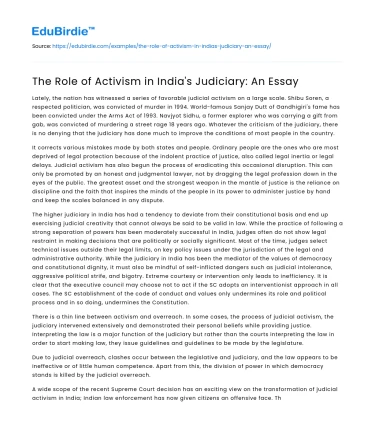Lately, the nation has witnessed a series of favorable judicial activism on a large scale. Shibu Soren, a respected politician, was convicted of murder in 1994. World-famous Sanjay Dutt of Gandhigiri's fame has been convicted under the Arms Act of 1993. Navjyot Sidhu, a former explorer who was carrying a gift from gab, was convicted of murdering a street rage 18 years ago. Whatever the criticism of the judiciary, there is no denying that the judiciary has done much to improve the conditions of most people in the country.
It corrects various mistakes made by both states and people. Ordinary people are the ones who are most deprived of legal protection because of the indolent practice of justice, also called legal inertia or legal delays. Judicial activism has also begun the process of eradicating this occasional disruption. This can only be promoted by an honest and judgmental lawyer, not by dragging the legal profession down in the eyes of the public. The greatest asset and the strongest weapon in the mantle of justice is the reliance on discipline and the faith that inspires the minds of the people in its power to administer justice by hand and keep the scales balanced in any dispute.
Save your time!
We can take care of your essay
- Proper editing and formatting
- Free revision, title page, and bibliography
- Flexible prices and money-back guarantee
The higher judiciary in India has had a tendency to deviate from their constitutional basis and end up exercising judicial creativity that cannot always be said to be valid in law. While the practice of following a strong separation of powers has been moderately successful in India, judges often do not show legal restraint in making decisions that are politically or socially significant. Most of the time, judges select technical issues outside their legal limits, on key policy issues under the jurisdiction of the legal and administrative authority. While the judiciary in India has been the mediator of the values of democracy and constitutional dignity, it must also be mindful of self-inflicted dangers such as judicial intolerance, aggressive political strife, and bigotry. Extreme courtesy or intervention only leads to inefficiency. It is clear that the executive council may choose not to act if the SC adopts an interventionist approach in all cases. The SC establishment of the code of conduct and values only undermines its role and political process and in so doing, undermines the Constitution.
There is a thin line between activism and overreach. In some cases, the process of judicial activism, the judiciary intervened extensively and demonstrated their personal beliefs while providing justice. Interpreting the law is a major function of the judiciary but rather than the courts interpreting the law in order to start making law, they issue guidelines and guidelines to be made by the legislature.
Due to judicial overreach, clashes occur between the legislative and judiciary, and the law appears to be ineffective or of little human competence. Apart from this, the division of power in which democracy stands is killed by the judicial overreach.
A wide scope of the recent Supreme Court decision has an exciting view on the transformation of judicial activism in India; Indian law enforcement has now given citizens an offensive face. The eyes of the Supreme Court of India have now gone far beyond the protection of the socially and economically disadvantaged and government officials. Its ideas, however, tend to be more ambitious than adherence to declarations. If we look at the post-emergency advocacy, we can see the Supreme Court surpassing the legal positivism.
The functioning of the justice system that operates as part of government for the people is enshrined in the provisions of the constitution. It is also necessary for other non-governmental institutions to work for the people.
The judicial activism as witnessed in India has been portrayed to be episodic and anecdotal in character. In India, a simple definition of judicial activism has been described by various scholars as ‘any judgment that is not related to the past, and that sets new guidelines or ideas is an activist’. In fact, the departure from the past and the separation from the past was required in the country in all the higher justice judgments. It is therefore clear that the judiciary should act in accordance with the requirements of the case. The judicial activism is a critical activity that involves ingenuity. Great skill and creativity are required.
So, in a nutshell, I would like to say that the concept of legal activism has both advantages and disadvantages. If the judiciary interferes with the functioning of other spheres of government and attempts to override the power of the constitution, then this concept of judicial activism loses its significance and context. Sometimes, lawmakers often rewrite their ideas in the name of activism, the belief in the separation of powers is dispelled.
The role of judicial activism is inescapable as it has played a key role in providing justice to the poorest sections of society, the poor, socially and academically, victims of trafficking, and under trial prisoners. Proper implementation of fundamental rights is possible only because of the development of judicial activism.






 Stuck on your essay?
Stuck on your essay?

